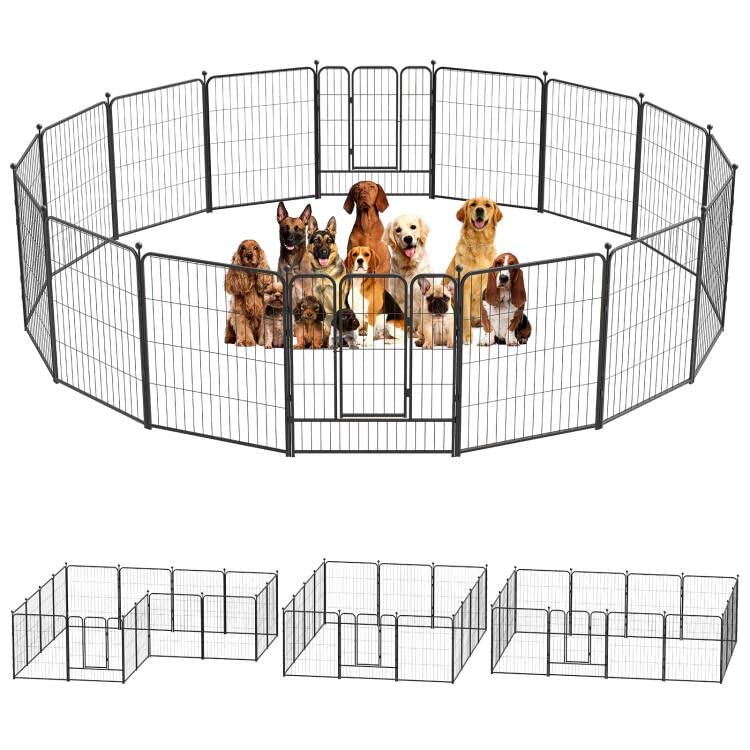Pet Tips
How to Crate Training Your Family Dog Step-by-Step Help Guide
How to Crate Training Your Family Dog Step-by-Step Help Guide
Crate Training is a valuable tool for dog owners who want to housebreak their puppies. It also provides them with a safe and comfortable space. We recommend the PawHut Folding Design Heavy Duty Metal Dog Crate & Kennel to ensure the best experience. This high-quality product is designed to meet all of your needs and is durable.
Prior to crate training, choosing the right crate is crucial. With 4 locking wheels and a removable tray and cover, the PawHut Folding Design Heavy Duty Metal Dog Cage Crate & Kennel costs $189.99 at https://petsuppliesshoponline.
Step-by-step instructions on how to crate train your dog
Choose the Right Crate Size
When choosing a crate, (You can see our slection here: https://petsuppliesshoponline.

Folding Design Heavy Duty Metal Dog Cage Crate & Kennel measures 49″, offering ample space for most breeds.
Introduce Your Dog to the Crate
Place the crate in a common area of your home, where your dog can easily see and access it. Leave the door open and encourage your dog to explore the crate by tossing treats or toys inside. Make sure to praise your dog when they enter the crate voluntarily. This process may take several days, so be patient and allow your dog to become comfortable with the new space.
Establish a Positive Association with the Crate
Create a comfortable environment inside the crate by adding a soft blanket, your dog’s favorite toys, and a water dish. You may also choose to cover the crate with a lightweight sheet to create a den-like atmosphere, further encouraging your dog to feel safe and secure inside.
Begin Feeding Meals Inside the Crate
Once your dog is comfortable entering the crate, begin feeding their meals inside. This will help them associate the crate with positive experiences. Close the door while your dog eats, gradually increasing the amount of time the door remains closed after they finish eating.
Practice Short Duration Crating
Start by crating your dog for short periods while you are at home. Encourage them into the crate using a treat or a command, such as “crate” or “kennel.” Close the door and remain nearby. Start with just a few minutes, gradually increasing the time your dog spends in the crate. Remember to reward your dog for remaining calm and relaxed.
Increase Crate Time and Begin Leaving Your Dog Alone
As your dog becomes more comfortable in the crate, begin leaving them alone for short periods. You can use this time to run errands or engage in activities outside the home. Gradually increase the duration of your absence, ensuring your dog remains calm and relaxed during this time.
Crate Your Dog Overnight
Once your dog is comfortable being left alone in the crate for extended periods, begin crating them overnight. This will help establish a consistent routine and further reinforce the crate as a secure and familiar environment. Place the crate in a location where your dog can still see and hear family members to alleviate any anxiety they may have during the night.
Create a Crate Schedule
A consistent schedule for your dog’s crate time with do wonders in how fast your pet learns to accept the crate. You can include designated times for meals, playtime, and bed. By adhering to a routine, your dog will easily adapt to their new environment and understand what is expected of them.
Try not to use the Crate for Punishment
It’s essential to maintain a positive train of thought with the crate. Never use it as a “time-out” or punishment space. If they associate the crate with negative things, they may learn not to enter it without fear or exhibit signs of anxiety and stress when crated.
Be Patient and Consistent
Crate training requires patience, consistency, and time. Some dogs may adapt quickly, while others may take weeks or even months to feel comfortable in their crate. Remain consistent in your training, praise, and reinforcement to help your dog develop a positive relationship with their crate.
In conclusion, crate training is an essential tool in fostering a sense of security and structure for your family dog. By following the steps outlined in this guide and investing in a high-quality crate like the PawHut Folding Design Heavy Duty Metal Dog Cage Crate & Kennel, you can ensure a successful and stress-free crate training experience for both you and your beloved pet.
Remember, the PawHut Folding Design Heavy Duty Metal Dog Cage Crate & Kennel is available at https://petsuppliesshoponline.






